
The oldest known surviving film was shot in the United Kingdom as well as early colour films. While film production reached an all-time high in 1936, the "golden age" of British cinema is usually thought to have occurred in the 1940s, during which the directors David Lean, Michael Powell, and Carol Reed produced their most critically acclaimed works. Many British actors have accrued critical success and worldwide recognition, such as Audrey Hepburn, Olivia de Havilland, Vivien Leigh, Glynis Johns, Maggie Smith, Laurence Olivier, Michael Caine, Sean Connery, Ian Mckellen, Joan Collins, Judi Dench, Julie Andrews, Daniel Day-Lewis, Gary Oldman, Emma Thompson, Anthony Hopkins, Peter O’Toole and Kate Winslet. Some of the films with the largest ever box office returns have been made in the United Kingdom, including the fourth and fifth highest-grossing film franchises.
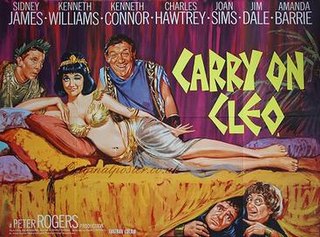
Carry On Cleo is a 1964 British historical comedy film, the tenth in the series of 31 Carry On films (1958–1992). Regulars Sid James, Kenneth Williams, Kenneth Connor, Charles Hawtrey, and Jim Dale are present and Connor made his last appearance until his return in Carry On Up the Jungle six years later. Joan Sims returned to the series for the first time since Carry On Regardless three years earlier. Sims would now appear in every Carry On up to Carry On Emmannuelle in 1978, making her the most prolific actress in the series. Jon Pertwee makes the first of his four appearances in the series. The title role is played by Amanda Barrie in her second and last Carry On. Along with Carry On Sergeant and Carry On Screaming!, its original posters were reproduced by the Royal Mail on stamps to celebrate the 50th anniversary of the Carry On series in June 2008. The film was followed by Carry On Cowboy 1965.

Oh, Mr Porter! is a 1937 British comedy film starring Will Hay with Moore Marriott and Graham Moffatt and directed by Marcel Varnel. While not Hay's commercially most successful, it is probably his best-known film to modern audiences. It is widely acclaimed as the best of Hay's work, and a classic of its genre. The film had its first public showing in November 1937 and went on general release on 3 January 1938. The plot of Oh, Mr Porter was loosely based on the Arnold Ridley play The Ghost Train. The title was taken from Oh! Mr Porter, a music hall song.

George Albert Smith was an English stage hypnotist, psychic, magic lantern lecturer, Fellow of the Royal Astronomical Society, inventor and a key member of the loose association of early film pioneers dubbed the Brighton School by French film historian Georges Sadoul. He is best known for his controversial work with Edmund Gurney at the Society for Psychical Research, his short films from 1897 to 1903, which pioneered film editing and close-ups, and his development of the first successful colour film process, Kinemacolor.

Mancunian Films was a British film production company first organised in 1933. From 1947 it was based in Rusholme, a suburb of Manchester, and produced a number of comedy films, mostly aimed at audiences in the North of England.

Carry On Nurse is a 1959 British comedy film, the second in the series of 31 Carry On films (1958–1992). Of the regular team, it featured Joan Sims, Kenneth Williams, Kenneth Connor and Charles Hawtrey, with Hattie Jacques and Leslie Phillips. The film was written by Norman Hudis based on the play Ring for Catty by Patrick Cargill and Jack Beale. It was the top-grossing film of 1959 in the United Kingdom and, with an audience of 10.4 million, had the highest cinema viewing of any of the "Carry On" films. Perhaps surprisingly, it was also highly successful in the United States, where it was reported that it played at some cinemas for three years. The film was followed by Carry On Teacher 1959.
Raymond Durgnat was a British film critic, who was born in London to Swiss parents. During his life he wrote for virtually every major English language film publication. In 1965 he published the first major critical essay on Michael Powell, who had hitherto been "fashionably dismissed by critics as a 'technician's director'", as Durgnat put it.

It's Great to Be Young is a 1956 British Technicolor musical comedy film directed by Cyril Frankel and starring Cecil Parker and John Mills. It was written by Ted Willis. The story concerns an inspirational school music teacher.
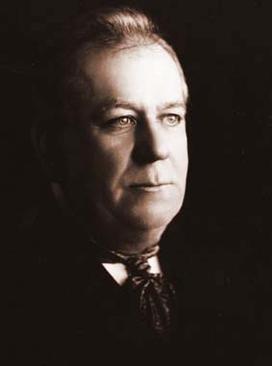
William Haggar was a British pioneer of the cinema industry. Beginning his career as a travelling entertainer, Haggar, whose large family formed his theatre company, later bought a Bioscope show and earned his money in the fairgrounds of south Wales. In 1902 he began making his own short fictional films, making him one of the earliest directors in Britain. His films were shown worldwide and his short Desperate Poaching Affray is believed to have influenced early narrative drama in American film, especially in chase genre. As a director Haggar is recognised for his use of editing and the depth of staging in his melodramas and crime films.
Arthur Melbourne Cooper was a British photographer and early filmmaker best known for his pioneering work in stop-motion animation. He produced over three hundred films between 1896 and 1915, of which an estimated 36 were all or in part animated. These include Dreams of Toyland (1908) and according to some sources Dolly’s Toys (1901), as well as Matches: An Appeal, which Dutch independent researcher Tjitte de Vries has claimed may have been the first animated film to be shown in public.
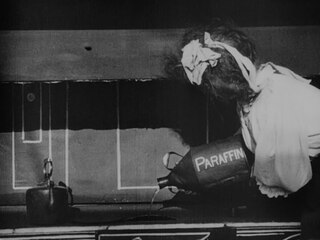
Mary Jane's Mishap; or, Don't Fool with the Paraffin is a 1903 British silent comic trick film, directed by George Albert Smith, depicting disaster after housemaid Mary Jane uses paraffin to light the kitchen stove.

Explosion of a Motor Car is a 1900 British silent comic trick film, directed by Cecil M. Hepworth, featuring an exploding automobile scattering the body parts of its driver and passenger. "One of the most memorable of early British trick films" according to Michael Brooke of BFI Screenonline, "was one of the first films to play with the laws of physics for comic effect." It features one of the earliest known uses in a British film of the stop trick technique discovered by French filmmaker Georges Méliès in 1896, and also includes one of the earliest film uses of comedy delay – later to be widely used as a convention in animated films – where objects take much longer to fall to the ground than they would do in reality. It is included in the BFI DVD Early Cinema: Primitives and Pioneers and a clip is featured in Paul Merton's interactive guide to early British silent comedy How They Laughed on the BFI website.

Santa Claus is an 1898 British silent trick film directed by George Albert Smith, which features Santa Claus visiting a house on Christmas Eve. The film, according to Michael Brooke of BFI Screenonline, "is believed to be the cinema's earliest known example of parallel action and, when coupled with double-exposure techniques that Smith had already demonstrated in the same year's The Mesmerist (1898) and Photographing a Ghost (1898), the result is one of the most visually and conceptually sophisticated British films made up to then." It has been described as the very first Christmas movie and a technical marvel of its time.

The Countryman and the Cinematograph is a 1901 British short silent comedy film, directed by Robert W. Paul, featuring a stereotypical yokel reacting to films projected onto a screen. The film "is one of the earliest known examples of a film within a film", where, according to Michael Brooke of BFI Screenonline, "the audience reaction to that film is as important a part of the drama as the content of the film itself".
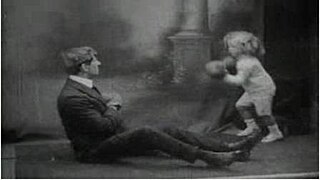
The Man to Beat Jack Johnson is a 1910 British short black-and-white silent comedy film, produced by the Tyler Film Company, featuring four-year-old Willy Sanders demonstrating his boxing and wrestling skills against an adult opponent.

The Biter Bit is an 1899 British short black-and-white silent comedy film, produced by Bamforth & Co Ltd, featuring a boy playing a practical joke on a gardener by grasping his hose to stop the water flow and then letting go when the gardener looks down it to check. The film "is an English remake" of Auguste and Louis Lumière's L'Arroseur Arrosé (1895), according to Michael Brooke of BFI Screenonline, "providing a good illustration of how early film production companies cheerfully plagiarised each other's work" with "a few minor differences between, most notably a rather greater sense of space and depth in the Bamforth version" and "three distinct planes to the action". It is included in the BFI DVD Early Cinema: Primitives and Pioneers and a clip is used in Paul Merton's interactive guide to early British silent comedy How They Laughed on the BFI website.
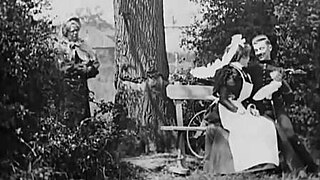
Tommy Atkins in the Park is an 1898 British short black-and-white silent comedy film, directed by Robert W. Paul, featuring a couple courting in a park who are forced to use desperate measures to get rid of a stout matron who interrupts them. The film was a remake of Alfred Moul's The Soldier's Courtship (1896). It is included on the BFI DVD R.W. Paul: The Collected Films 1895-1908 and a clip is featured in Paul Merton's interactive guide to early British silent comedy How They Laughed on the BFI website.

Willie's Magic Wand is a 1907 British silent comic trick film, directed by Walter R. Booth, featuring a young boy terrorising the household with his father's magic wand.

Never Back Losers is a 1961 British 'B' crime film directed by Robert Tronson and starring Jack Hedley, Jacqueline Ellis and Patrick Magee. It was written by Lucas Heller based on the 1929 novel The Green Ribbon by Edgar Wallace. It was one of the Edgar Wallace Mysteries series, produced at Merton Park Studios in the early 1960s.
Early Fashions on Brighton Pier is a 1898 British silent actuality film, generally considered to be shot by Scottish film pioneer James Williamson. Previously, the film had been credited to George Albert Smith. The more recent attribution to Williamson is based mainly on the identification of two of Williamson's sons in the pier crowd. It is categorised in the Screen Archive South East as On the West Pier.

















